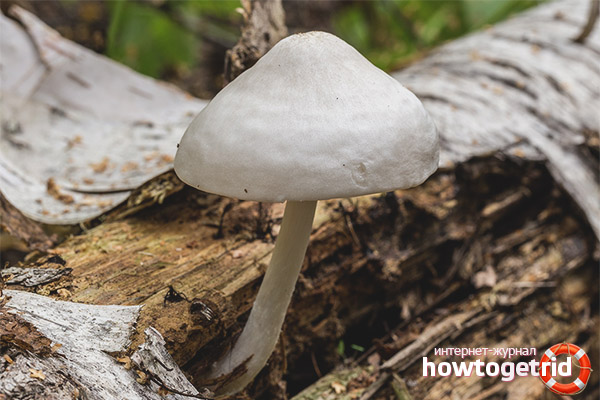The content of the article
The rogue belongs to the Plytean family, there are quite a lot of representatives, but today we will consider the lion-yellow. Growth is carried out on diseased or rotten trees. The distribution is wide, so finding the next bright yellow inhabitant will not be difficult in the forest strip. However, despite the vast territory of growth and impressive external data, lovers of quiet hunting are in no hurry to throw these fruiting bodies into their basket. In today's article, we will study everything that affects this species.
Description
- The apex in its diameter fluctuates within 6 cm. Maximum. Initially, its format resembles a bell, but then it becomes flat with a smooth convexity. The hat is quite thin and hanging around the edges. It is matte with some velvety. But it can be smooth and glossy, ultimately it all depends on climatic conditions, the region of growth, as well as weather conditions at a particular time.
- The hat is pigmented in a yellow tone with some brownish blotches, although not always. Often you can find bright honey representatives with a yellow prevailing color. In the central part there is a tubercle, which has a mesh type pattern. The edges are ribbed, streaked. The plates are quite extensive, close to each other, hanging freely. They are painted yellow and white, they turn pink in old age.
- The base is thin and long, stretches up to 9 cm in height with a thickness of about 5 mm. Format like a cylinder. Expansion is seen in the lower section, closer to the soil. The leg itself is curved, but can be even, as well as twisted. Fibers on the base are available, yellow or so. Brown shades or darkness may be seen. The soft part is compacted and whitish, smells good, taste is weak. Spores of a pinkish pigment.
- It makes sense to affect the edibility of the presented copies. Despite the fact that this fruiting body is considered edible, the taste is not distinct, the mushroom itself is of poor quality. Before consumption and further cooking, a 15-minute digestion is carried out, then you can make twists, first / second dishes, etc. The mushroom is suitable for drying and salting.
Spread
- It was previously mentioned that these representatives of the mushroom family live in larches. They like to be located next to beech, oak, birch, aspen. With special rarity mushroom pickers manage to meet similar fruiting bodies in the coniferous strip.
- By its natural features, the reduced fruit body is saprophyte. Simply put, it prefers to settle on dying trees, rotting bark, stumps. There are also mushrooms on the roots, perching closer to the soil. It is extremely rare to settle on a living tree, but this is likely.
Noble whip
- Such fruiting bodies belong to the group of inedible mushrooms. As for the fruiting period, specimens are found in forests from mid-summer to mid-autumn. At a noble plutee you can observe a white hat.
- In rare cases, it is painted in gray or slightly yellowish color. The edges are lowered and at the same time they are even. The leg has a light color. In addition, in some fruiting bodies, it may have a brownish coating.
- Such a mushroom can be found in the forests of the Russian Federation. As mentioned earlier, the hat of such specimens is painted in brown or grayish color. In addition, in more mature mushrooms, its edges begin to bulge up.
- Leg of specimens is glossy and painted in light color. As for the plates, they are not located close to each other.They have a gray color. The fungus has a double called a scaly-like dope. However, the latter has a smaller size. Scales are expressed much more strongly.
White whip
- Such a fruiting body has a leg up to 12 cm high. However, its thickness cannot exceed 2 cm. Inside it is not hollow, fibers and pulp are present. The color is completely white. The leg has a dense structure.
- The hat of such specimens in diameter grows to 13 cm. Moreover, in structure, it is slightly fleshy and brittle. In young fruiting bodies, the hat has the shape of a hemisphere. With age, it gradually unfolds.
- The structure of the cap is fibrous and silky to the touch. The color is white, there are small scales on the surface. Young mushrooms have infrequent white plates. As for the pulp, it is soft and whitish. If you cut the fruit, the color will not change. The aroma is practically absent.
Fruit bodies are suitable for food, but do not forget that such mushrooms are not famous for their high taste. When collecting these copies, be careful not to confuse them with similar species and doubles.
Video: lion-yellow whip (Pluteus leoninus)











Submit